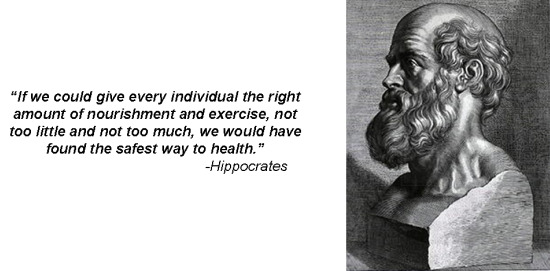Healthy Weight
Maintaining a healthy weight boils down to a very simple notion – we lose weight when we burn more calories than we eat, and we gain weight when we eat more calories than we burn. So much like our household budget, we need to manage "what’s coming in and what’s going out" on a regular basis. But therein lies the challenge for many of us!
Now that we’re in our midlife stages, maintaining a healthy weight becomes more difficult. Our muscle fibers start to shrink in size and number with age, a process known as muscle atrophy. We start to gain fat, especially around the middle, and atrophy is counterproductive to losing weight (fat burns fewer calories than muscle). Our loss of muscle mass is related to, and perhaps partially caused by, a slower metabolic rate which also comes from age.
So what’s our remedy? Any quick fixes or miracle discoveries lately – what's the current rage? Actually, the best remedy has been known for a long time, many centuries in fact, going all the way back to the time of Hippocrates, a Greek physician who lived during the 4th century before Christ, and generally known as the father of western medicine:

Now if we fast forward to today – at least to our high school algebra class – we would have a formula that looks like this:
Safest Way to Health = Nourishment + Exercise, or
Boomer Fitness = Diet + [Exercise], or
Boomer Fitness = Diet + [Cardio Exercise and Strength Training Exercise]
Since we probably find eating a lot easier than exercise, let’s start with some basics as outlined below, then we'll see what it means to eat healthy, the fundamentals of cardio exercise and strength training, and other health tips. First the basics:
Achieving a Healthy Weight – Know Your Body Type and Plan Accordingly
Regardless of age, each of our bodies can be categorized by certain characteristics, which in turn determine how soon – and how much – success we have in getting fit and maintaining a healthy weight. Allowing for some “cross-over” tendencies, there are three (3) distinct body types to which each of us have “morphed” - an Ectomorph, an Endomorph, or a Mesomorph:
Ectomorph – a body shape
characterized by long slender arms and legs, a narrow chest and
abdomen, with little body fat and little muscle.
An ectomorph (aka long and lanky) has difficulty gaining muscle mass, but can lose fat easily. For that reason, cardio exercise is more essential for conditioning than it would be for losing fat. High intensity exercise (strength training) would be necessary for muscle gain, but since muscle recovery is slow, such exercise should be less frequent and of shorter duration. Metabolism is higher, and so these bodies will need more calories from protein and good fat, and some may require more carbohydrates as well.
- Endomorph – a body shape
characterized by a round head, a large, round abdomen, short arms and
legs with fat upper arms and thighs, but slender wrists and ankles, with
a lot of body fat.
An endomorph has more difficulty losing fat, and at times will have difficulty gaining muscle. Cardio is essential for fat loss, and such exercise should be higher intensity and more frequent; recovery time is fairly quick. Calorie intake must be controlled because metabolism is slower; more protein is needed.
- Mesomorph – a body shape
characterized by well-defined muscles and large bones, well developed
arms and legs, and the torso tapered to a relatively narrow and low
waist (gains fat more easily than ectomorphs).
A mesomorph with its stocky, thicker muscles gains muscle mass very easily and can also lose fat easily. Cardio is best for fat loss, but mesomorph bodies respond well to either high volume or high intensity exercise as recovery time is quick. Calorie intake is generally not an issue if an overall balance is maintained, since the metabolism rate is fairly high.
So, what type of body are you? The temptation is to compare our results with everyone else, or take a one-size-fits-all approach. By recognizing the type of body we have, we can tailor our efforts to our own specific needs and capabilities, with less worry for how long it takes getting there. The keys are knowing “what” we are, being realistic, and staying committed to a healthy weight.
Maintaining a Healthy Weight – Keys to Success
Over the past century, major advancements in medicine and nutrition produced greater longevity. In the early 1900s, people ate whatever was available, exercise was mostly limited to physical labor, and the average life expectancy was less than 50. But by 2000, our parents were expected to live well into their 70s at least, just by virtue of those advancements. There was no concerted effort on their part, no real concern for maintaining a healthy weight level.

As our parents grew older, their activity levels generally dropped. Studies have shown that 60% of all adults over 75 no longer participate in any type of physical activity. But more so than our parents, we know now that a sedentary lifestyle brings at least as much risk for ailments such as heart disease, stroke, diabetes, high blood pressure, colon cancer, obesity and osteoporosis as does advanced age.
When it comes to aging, we boomers have a pretty clear choice. Sure, we can never stop the hands of time, but isn’t it better if those hands just touch us instead of giving us a head slap?
The all important first steps to finding and maintaining a healthy weight:
1. Assess Your Condition

- Calculate your body mass index (at least 2/3 of all American adults would be classified as overweight or obese).
- Nearly 25% of all Americans are currently on some sort of diet, and most (95%) will fail.
- Preventative steps now are easier and less expensive than “reactive” care (think what that might do to health care costs nationally…)
- Always best to have your doctor recommend a diet and exercise program that matches your current condition of health; normally we see our doctor for specific items, but it's essential to assess ALL of our parts, moving and otherwise!
2. Set Personal Goals and Commit
- Understand your body type to know what is realistic for you, as outlined above.
- Create a vision for what you want to achieve, in a form that reminds you everyday (it may seem hokey, but a picture on the refrigerator that you and others in your household see everyday will help you stay accountable).
- Know that you didn’t get heavy and out of shape overnight, and that a "hard body" won’t come overnight either.
- Know that you’re doing this for YOU, and quite likely for the ones you love.
- Be accountable to yourself and/or a personal trainer, other family members, friends, members of your fitness class, anyone that you look in the eye on a regular basis.
3. Start Slow and Make Gradual Progress
- Take one step at a time; “crash” programs do just that – crash!
- Plan to achieve milestones, not plateaus.
- Walking is a great start, and add strength training as you progress (see Low Impact Cardio Exercise).
- Don’t skip any meals.
- Start reading labels of food packages and know what to avoid (see Eating Right).
- Give yourself enough time to see results.
4. Make the Right Choices

- Gather the lists of healthy food choices and exercises based upon your doctor’s advice.
- The best choices from those lists are the foods you’ll eat and the exercises you’ll do, so choose the ones you like (without cheating).
- Give yourself enough variety in your food menus and exercise routines to keep your interest; avoid repetition.
5. Don’t Forget the Simple Things:
- Sleep – 7 to 8 hours each night at the same times.
- Drink water to stay hydrated – when was the last time you drank 7-8 glasses of water in a day?
- Organize your daily schedule to allow at least 30 minutes for exercise.

- Always stretch before and after exercising.
- Eat breakfast each day – a balance of carbohydrates, protein and fat to get your metabolism going.
- Manage your stress – first slow down, write out the things that bring you stress, organize them like a “to do” list and then do what’s necessary to resolve each item, one at a time.
6. Start Today
- Getting to a healthy weight - and then maintaining it - may be challenging, but always consider the benefits vs. the consequences.
- Know that success is largely determined just by showing up!
- Home ›
- Healthy Life ›
- Healthy Weight
